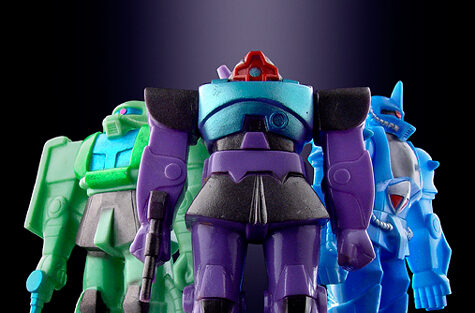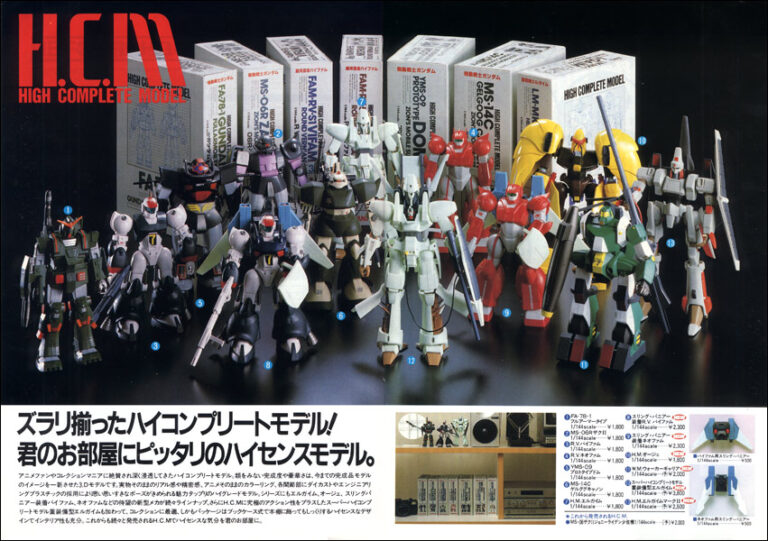
Ark’s series of six “Arklon” diecast monster toys represent everything that’s right about Japanese toy-design. Founded in the mid-1970s as a distribution subsidiary of famed vinyl maker Bullmark, Ark rose to brief prominence after its parent company’s untimely demise in 1977. Under the control of former Bullmark executive Saburo Ishizuki, Ark became a full-fledged manufacturer in its own right, creating “cheapie” toys, vinyl monster figures, and some of the most unique and action-packed diecast toys ever produced by a Japanese toy manufacturer.
The Ark diecasts are a subtle pleasure to be slowly savored. With the exception of one piece, they’re all characters from the Ultraman series of shows. And at first glance, it’s easy to underestimate the intricate genius of the toys. Upon closer inspection, it becomes clear that each individual part of every Ark diecast is interchangeable with the parts of the others. Various body modules contain missile launchers, rotating gears, and other tiny mechanisms;
![[combined toys]](https://toyboxdx.com/datafiles/data/ark/images/combined.gif)
the boxes come stuffed with auxiliary attachments such as wheels and axles, wind-up vehicles, and extra limbs, like some sort of twisted alien Erector set. It is as if the figures were designed by monster-crazed watchmakers rather than toy engineers. The price of this modular charm is extreme fragility: Ark used tiny plastic pegs to anchor the chunky metal body-units of the monsters together, which means that a large percentage of surviving specimens are cracked and broken.
Perhaps the most amusing aspect of these toys is that, in spite of their awe-inspiring range of play value, they look very little like the actual monsters they’re supposed to portray. With the exception of one piece, King Joe, every single Ark diecast is a “mechanized” version of a fleshy giant monster. Perhaps it was felt that “straight” portrayals wouldn’t be interesting enough for the kids, or that diecast couldn’t accurately capture the feel of a rubbery monster; perhaps the designers were simply hopped-up on methamphetamine and cheap sake. Whatever the case, it led to a series of the most creatively gimmick-packed toys ever produced.
Consider the bizarre King Kong piece. As if to highlight his primitive nature, the toy comes with a prisoner’s ball-and-chain restraint and a pair of spring-loaded knives that thrust forth from his nipples at the caress of a switch. And instead of providing the toy with Kong’s trademark airplanes to snatch out of the sky, Ark rigged King Kong to actually launch a large cardboard glider from a hole in his stomach. The genius of Ark’s diecasts is their abstraction, their impression, their distilled “essence of kaiju” that highlights the FEEL rather than the LOOK of a given monster. They combine every facet of a character’s being into a single form. They are diecast by way of Picasso.
The original Japanese packaging for the Ark diecasts is incredibly colorful and playful. The backs of the boxes showed various ways of combining the characters, complete with silly descriptive captions (such as “I’m good at being a bad boy!” and “What a weirdo!”)
![[Ark logos]](https://toyboxdx.com/datafiles/data/ark/images/ark_logos.gif)
The full series of Arklon diecasts were also sold in the USA by the late, great Marukai Trading Company. With the exception of being repackaged in English boxes, the toys were nearly identical to their Japanese counterparts.
Thanks to Yutaka Ishida / Kaikodo, Giovanni Vaciago, and Alen Yen for images
01 King Joe, V1 + V2
King Joe was produced in two variations. This first version is a decent rendition of the famed Ultraman villain, although it doesn’t disassemble as the more accurate Popy version does. This piece was the first of the Ark diecasts and is the only one of the series to be sold in a solid box without a window. It was only available in a Japanese-language box.
In the second, later version of King Joe, for some reason Ark felt the need to totally rework the toy by repainting the head and replacing the thighs and forearms with chunky red plastic pieces. The effect of the change is underwhelming — where the first version has a subtle, understated charm, the “remake” manages to look like Ultra-Kaiju by way of Bozo the Clown. Both versions were available in Japan, but only this second version made it to U.S. shelves.
02 Mecha Baltan Seijin
“Mecha Baltan” was kind of an odd choice for the name of this toy, as it’s the most accurately non-mechanical portrayal of the bunch. It also looks nothing like the actual “Mecha-Baltan” that appeared in later episodes of the Ultraman series. Whatever. In any event, although it’s a relatively common piece in the ‘States, it’s highly sought after in Japan.
03 Mecha black King
Saddled with the unlikely nickname of “Yojimbo-Kaiju” (“Bodyguard Monster”), Black King is one of the rarest pieces in the Ark lineup. It also features an extremely fragile waist joint that is very, very easily broken. The upper torso rotates when a gear on his stomach is turned. The angular, aggressive sculpt of the head is satisfyingly fierce.
03x Mecha Red King
Just as with Black King, Red King’s waist-joint is exceedingly fragile. In fact, this difficult-to-find toy is said to be a “brother piece” to Black King (and even features a nearly identical serial number), but there is very little common mold-use between the two besides the waist and biceps. Red King’s eight-chambered, dial-actuated gatling missile launcher is a perennial favorite. Although Ark gave him the ferocious-sounding nickname of “Skull Monster,” his head actually resembles that of a cow or sheep….
04 Mecha Gomora
This is quite possibly the most abstract portrayal out of the entire bunch. Gomoras hands have been replaced with shovels, his neck can extend to twice its length, and the body features a tiny (and easily broken) spring-powered car that can attach to the chest. The name can also be romanized as “Gomola.”
05 King Kong
Although it was sold in the USA under the generic name of “Mech-Gorilla,” in Japan this piece was a licensed portrayal of the famous American monster. It is also the only piece in the Ark lineup that is not related to the Ultraman series. The American version did not include the ball-and-chain accessory. King Kong is also the main piece of circumstantial evidence linking Ark to Bullmark: the license info in the Ark catalog lists Takara and Mego as copyright holders, with Bullmark as the producer.

![[Ark catalog]](https://toyboxdx.com/datafiles/data/ark/images/catalog_logopic.gif)
![[Kong airplane]](https://toyboxdx.com/datafiles/data/ark/images/kongplane_logopic.gif)



























